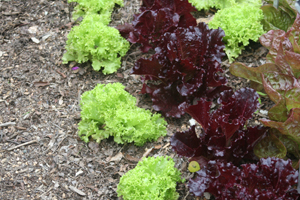
Lettuce (Lactuca sativa) is a cool-season vegetable that can be planted in early fall or early spring in Georgia. Lettuce enjoys cool temperatures and can even tolerate a light frost, but extremely cold or hot weather will cause it to perish. Choose an area that receives at least 8 to 10 hr of sunlight per day.
Soil Requirements
Lettuce can be grown on a wide range of soils but does best on fertile sandy loam soils that are well supplied with organic matter. While lettuce needs sufficient moisture, soggy soils and areas with poor drainage should be avoided. Lettuce is an excellent candidate for growing in raised beds or containers. Like many other garden crops, lettuce prefers a slightly acidic soil with a pH of 6.0 to 6.5.
Planting
Lettuce can be either direct seeded or started 5 or 6 weeks earlier inside the house or greenhouse. Lettuce grown in cold frames will take longer to grow and may require 10 to 12 weeks to form a suitable transplant. Prepare the seed bed by tilling to a depth of 8 to 10 in. and removing any large soil clods, sticks or stones. In the absence of a soil test, incorporate 3 to 4 lb of 5-10-10 fertilizer per 100 sq ft of garden area. Smooth the planting area carefully, as a well-prepared seed bed is essential. Lettuce transplants should be left outside for 4 to 5 days to become acclimated to outdoor temperatures prior to planting in the garden. Space plants 10 to 12 in. apart in rows that are 18 to 24 inches apart. Direct seeded lettuce can be planted in similar rows or broadcast over the entire bed. If broadcast, seedlings will need to be thinned appropriately to allow space between plants. Lettuce seed is very tiny; therefore, do not plant it too deeply. Seed should be worked in under the soil surface to a depth of 1/8 to 1/4 in. deep and the seed bed firmed lightly with your hand or the top of a hoe to allow maximum sunlight for good germination.
Irrigation
Lettuce seed and transplants should be watered frequently the first 2 weeks to keep the seed bed moist but not waterlogged. This moist establishment period is essential to get the crop up and growing. Continue to irrigate lettuce every 4 to 5 days as needed to keep the plants healthy and producing. Lettuce grown in raised beds or containers will need to be irrigated more frequently. Lack of moisture can sometimes cause lettuce leaves to taste bitter. Drip irrigation or soaker hoses are the best way to irrigate, but overhead irrigation can also be used when necessary.
Fertilizer
After the initial fertilizer application at planting, apply 2 lb of 5-10-15 per 100 sq ft of bed each month during the growing season. If a soil test has been taken, follow those recommendations.
Weed Control
Because lettuce seed is so tiny, it is important to keep developing weeds from competing with the young lettuce crop. Cultivation, weed control fabrics and mulch are all good organic methods to control weeds. Registered herbicides can also be applied if other measures fail.
Insects and Disease
Lettuce can be attacked by a number of insects, including aphids, armyworms, beetles, and cabbage loopers. Diseases may include damping-off, mildews, and leaf spots. Both insects and diseases can be controlled primarily by using sound cultural garden practices and recommended chemicals when necessary.
Harvest
Harvest the older, outer leaves as soon as they are large enough to use. Such harvesting can occur as the plants mature. If fully developed plants become too crowded, pull out every other plant to leave more room for the others. Lettuce can be stored in the refrigerator for up to a week. Keep lettuce in bags in the crisper drawer to maintain high moisture.
Varieties
Several types of lettuce can be grown in the home garden. Head lettuce, like those found in supermarkets, do not grow well in the hot Georgia climate and should be avoided. Leaf lettuce does well and may come in various colors with leaves that are smooth, round, wrinkled, serrated or curled. Romaine lettuce forms loose upright plants and can be harvested either as whole plants or the outer leaves can be pulled off a little at a time. Bibb lettuce forms small loose heads and has a mild buttery flavor.
Specific Selections
Romaine: Green Towers, Cimmaron, Super Jericho, and Marshall
Loose Leaf: Slobolt, Red Sails, Royal Oak Leaf, Black-seeded Simpson, Ruby, Multigreen 3, and Majesty
Bibb: Buttercrunch, Fire and Ice, Little Gem, and Summer Bibb
Status and Revision History
Published on May 23, 2012
Published with Full Review on Apr 06, 2015
Published with Full Review on Jul 13, 2022


























































